Conflict Resolution and Management: Aaron and Anne Case Study Analysis
VerifiedAdded on 2021/03/15
|9
|3581
|52
Case Study
AI Summary
This assignment presents a case study focusing on conflict resolution strategies within a workplace setting. It analyzes the conflicts between Aaron and Anne, exploring potential strategies and tactics for conflict resolution, including collaboration and mediation. The assignment delves into the ramifications of actions taken in response to workplace errors and evaluates the advantages and disadvantages of informal dispute resolution versus mediation. The student identifies the interpersonal conflict dynamics, proposes solutions, and examines the consequences of different approaches, aiming to provide insights into effective conflict management. The assignment emphasizes the importance of understanding both parties' interests and needs to achieve positive outcomes, providing a comprehensive analysis of the case study scenario.
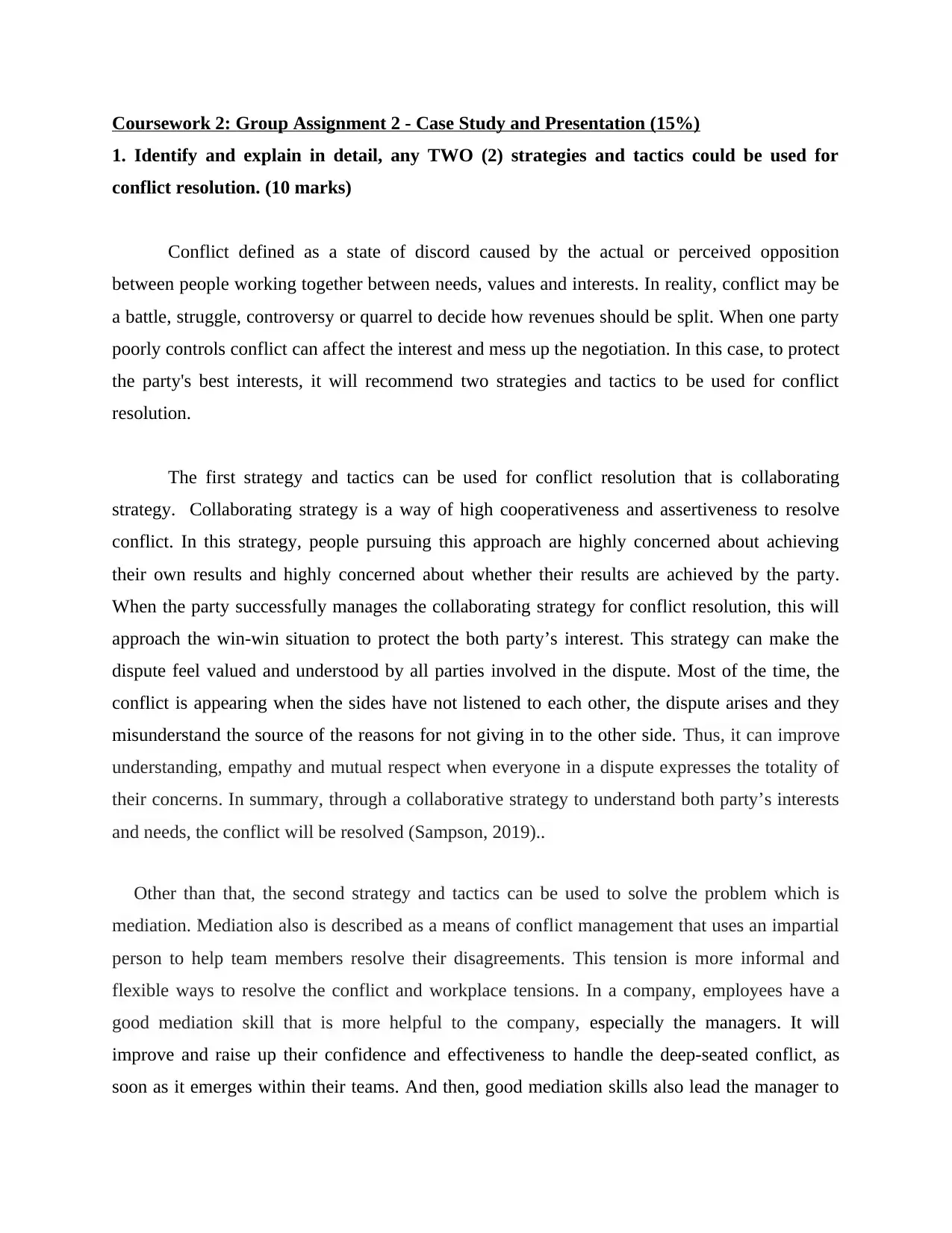
Coursework 2: Group Assignment 2 - Case Study and Presentation (15%)
1. Identify and explain in detail, any TWO (2) strategies and tactics could be used for
conflict resolution. (10 marks)
Conflict defined as a state of discord caused by the actual or perceived opposition
between people working together between needs, values and interests. In reality, conflict may be
a battle, struggle, controversy or quarrel to decide how revenues should be split. When one party
poorly controls conflict can affect the interest and mess up the negotiation. In this case, to protect
the party's best interests, it will recommend two strategies and tactics to be used for conflict
resolution.
The first strategy and tactics can be used for conflict resolution that is collaborating
strategy. Collaborating strategy is a way of high cooperativeness and assertiveness to resolve
conflict. In this strategy, people pursuing this approach are highly concerned about achieving
their own results and highly concerned about whether their results are achieved by the party.
When the party successfully manages the collaborating strategy for conflict resolution, this will
approach the win-win situation to protect the both party’s interest. This strategy can make the
dispute feel valued and understood by all parties involved in the dispute. Most of the time, the
conflict is appearing when the sides have not listened to each other, the dispute arises and they
misunderstand the source of the reasons for not giving in to the other side. Thus, it can improve
understanding, empathy and mutual respect when everyone in a dispute expresses the totality of
their concerns. In summary, through a collaborative strategy to understand both party’s interests
and needs, the conflict will be resolved (Sampson, 2019)..
Other than that, the second strategy and tactics can be used to solve the problem which is
mediation. Mediation also is described as a means of conflict management that uses an impartial
person to help team members resolve their disagreements. This tension is more informal and
flexible ways to resolve the conflict and workplace tensions. In a company, employees have a
good mediation skill that is more helpful to the company, especially the managers. It will
improve and raise up their confidence and effectiveness to handle the deep-seated conflict, as
soon as it emerges within their teams. And then, good mediation skills also lead the manager to
1. Identify and explain in detail, any TWO (2) strategies and tactics could be used for
conflict resolution. (10 marks)
Conflict defined as a state of discord caused by the actual or perceived opposition
between people working together between needs, values and interests. In reality, conflict may be
a battle, struggle, controversy or quarrel to decide how revenues should be split. When one party
poorly controls conflict can affect the interest and mess up the negotiation. In this case, to protect
the party's best interests, it will recommend two strategies and tactics to be used for conflict
resolution.
The first strategy and tactics can be used for conflict resolution that is collaborating
strategy. Collaborating strategy is a way of high cooperativeness and assertiveness to resolve
conflict. In this strategy, people pursuing this approach are highly concerned about achieving
their own results and highly concerned about whether their results are achieved by the party.
When the party successfully manages the collaborating strategy for conflict resolution, this will
approach the win-win situation to protect the both party’s interest. This strategy can make the
dispute feel valued and understood by all parties involved in the dispute. Most of the time, the
conflict is appearing when the sides have not listened to each other, the dispute arises and they
misunderstand the source of the reasons for not giving in to the other side. Thus, it can improve
understanding, empathy and mutual respect when everyone in a dispute expresses the totality of
their concerns. In summary, through a collaborative strategy to understand both party’s interests
and needs, the conflict will be resolved (Sampson, 2019)..
Other than that, the second strategy and tactics can be used to solve the problem which is
mediation. Mediation also is described as a means of conflict management that uses an impartial
person to help team members resolve their disagreements. This tension is more informal and
flexible ways to resolve the conflict and workplace tensions. In a company, employees have a
good mediation skill that is more helpful to the company, especially the managers. It will
improve and raise up their confidence and effectiveness to handle the deep-seated conflict, as
soon as it emerges within their teams. And then, good mediation skills also lead the manager to
Paraphrase This Document
Need a fresh take? Get an instant paraphrase of this document with our AI Paraphraser
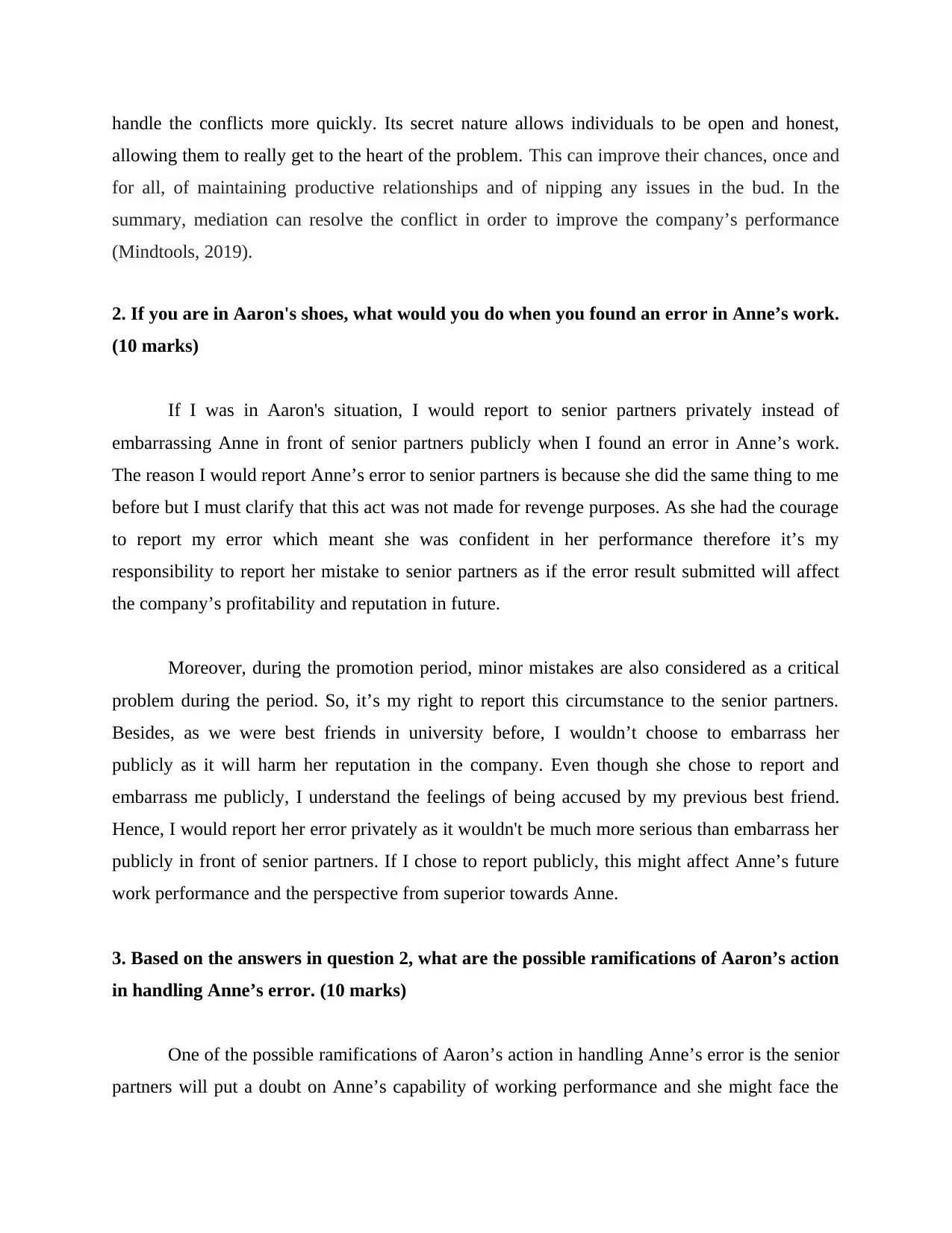
handle the conflicts more quickly. Its secret nature allows individuals to be open and honest,
allowing them to really get to the heart of the problem. This can improve their chances, once and
for all, of maintaining productive relationships and of nipping any issues in the bud. In the
summary, mediation can resolve the conflict in order to improve the company’s performance
(Mindtools, 2019).
2. If you are in Aaron's shoes, what would you do when you found an error in Anne’s work.
(10 marks)
If I was in Aaron's situation, I would report to senior partners privately instead of
embarrassing Anne in front of senior partners publicly when I found an error in Anne’s work.
The reason I would report Anne’s error to senior partners is because she did the same thing to me
before but I must clarify that this act was not made for revenge purposes. As she had the courage
to report my error which meant she was confident in her performance therefore it’s my
responsibility to report her mistake to senior partners as if the error result submitted will affect
the company’s profitability and reputation in future.
Moreover, during the promotion period, minor mistakes are also considered as a critical
problem during the period. So, it’s my right to report this circumstance to the senior partners.
Besides, as we were best friends in university before, I wouldn’t choose to embarrass her
publicly as it will harm her reputation in the company. Even though she chose to report and
embarrass me publicly, I understand the feelings of being accused by my previous best friend.
Hence, I would report her error privately as it wouldn't be much more serious than embarrass her
publicly in front of senior partners. If I chose to report publicly, this might affect Anne’s future
work performance and the perspective from superior towards Anne.
3. Based on the answers in question 2, what are the possible ramifications of Aaron’s action
in handling Anne’s error. (10 marks)
One of the possible ramifications of Aaron’s action in handling Anne’s error is the senior
partners will put a doubt on Anne’s capability of working performance and she might face the
allowing them to really get to the heart of the problem. This can improve their chances, once and
for all, of maintaining productive relationships and of nipping any issues in the bud. In the
summary, mediation can resolve the conflict in order to improve the company’s performance
(Mindtools, 2019).
2. If you are in Aaron's shoes, what would you do when you found an error in Anne’s work.
(10 marks)
If I was in Aaron's situation, I would report to senior partners privately instead of
embarrassing Anne in front of senior partners publicly when I found an error in Anne’s work.
The reason I would report Anne’s error to senior partners is because she did the same thing to me
before but I must clarify that this act was not made for revenge purposes. As she had the courage
to report my error which meant she was confident in her performance therefore it’s my
responsibility to report her mistake to senior partners as if the error result submitted will affect
the company’s profitability and reputation in future.
Moreover, during the promotion period, minor mistakes are also considered as a critical
problem during the period. So, it’s my right to report this circumstance to the senior partners.
Besides, as we were best friends in university before, I wouldn’t choose to embarrass her
publicly as it will harm her reputation in the company. Even though she chose to report and
embarrass me publicly, I understand the feelings of being accused by my previous best friend.
Hence, I would report her error privately as it wouldn't be much more serious than embarrass her
publicly in front of senior partners. If I chose to report publicly, this might affect Anne’s future
work performance and the perspective from superior towards Anne.
3. Based on the answers in question 2, what are the possible ramifications of Aaron’s action
in handling Anne’s error. (10 marks)
One of the possible ramifications of Aaron’s action in handling Anne’s error is the senior
partners will put a doubt on Anne’s capability of working performance and she might face the
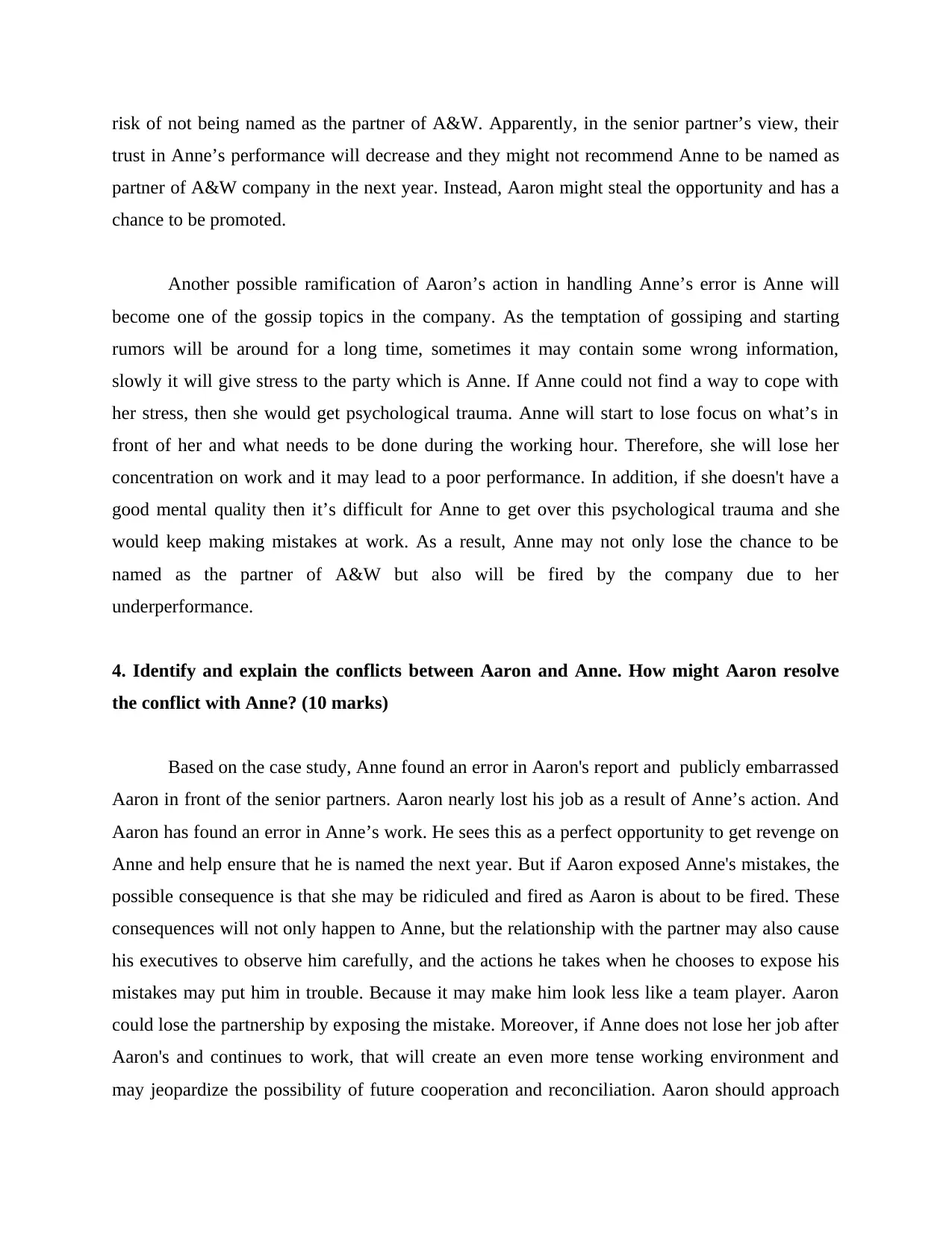
risk of not being named as the partner of A&W. Apparently, in the senior partner’s view, their
trust in Anne’s performance will decrease and they might not recommend Anne to be named as
partner of A&W company in the next year. Instead, Aaron might steal the opportunity and has a
chance to be promoted.
Another possible ramification of Aaron’s action in handling Anne’s error is Anne will
become one of the gossip topics in the company. As the temptation of gossiping and starting
rumors will be around for a long time, sometimes it may contain some wrong information,
slowly it will give stress to the party which is Anne. If Anne could not find a way to cope with
her stress, then she would get psychological trauma. Anne will start to lose focus on what’s in
front of her and what needs to be done during the working hour. Therefore, she will lose her
concentration on work and it may lead to a poor performance. In addition, if she doesn't have a
good mental quality then it’s difficult for Anne to get over this psychological trauma and she
would keep making mistakes at work. As a result, Anne may not only lose the chance to be
named as the partner of A&W but also will be fired by the company due to her
underperformance.
4. Identify and explain the conflicts between Aaron and Anne. How might Aaron resolve
the conflict with Anne? (10 marks)
Based on the case study, Anne found an error in Aaron's report and publicly embarrassed
Aaron in front of the senior partners. Aaron nearly lost his job as a result of Anne’s action. And
Aaron has found an error in Anne’s work. He sees this as a perfect opportunity to get revenge on
Anne and help ensure that he is named the next year. But if Aaron exposed Anne's mistakes, the
possible consequence is that she may be ridiculed and fired as Aaron is about to be fired. These
consequences will not only happen to Anne, but the relationship with the partner may also cause
his executives to observe him carefully, and the actions he takes when he chooses to expose his
mistakes may put him in trouble. Because it may make him look less like a team player. Aaron
could lose the partnership by exposing the mistake. Moreover, if Anne does not lose her job after
Aaron's and continues to work, that will create an even more tense working environment and
may jeopardize the possibility of future cooperation and reconciliation. Aaron should approach
trust in Anne’s performance will decrease and they might not recommend Anne to be named as
partner of A&W company in the next year. Instead, Aaron might steal the opportunity and has a
chance to be promoted.
Another possible ramification of Aaron’s action in handling Anne’s error is Anne will
become one of the gossip topics in the company. As the temptation of gossiping and starting
rumors will be around for a long time, sometimes it may contain some wrong information,
slowly it will give stress to the party which is Anne. If Anne could not find a way to cope with
her stress, then she would get psychological trauma. Anne will start to lose focus on what’s in
front of her and what needs to be done during the working hour. Therefore, she will lose her
concentration on work and it may lead to a poor performance. In addition, if she doesn't have a
good mental quality then it’s difficult for Anne to get over this psychological trauma and she
would keep making mistakes at work. As a result, Anne may not only lose the chance to be
named as the partner of A&W but also will be fired by the company due to her
underperformance.
4. Identify and explain the conflicts between Aaron and Anne. How might Aaron resolve
the conflict with Anne? (10 marks)
Based on the case study, Anne found an error in Aaron's report and publicly embarrassed
Aaron in front of the senior partners. Aaron nearly lost his job as a result of Anne’s action. And
Aaron has found an error in Anne’s work. He sees this as a perfect opportunity to get revenge on
Anne and help ensure that he is named the next year. But if Aaron exposed Anne's mistakes, the
possible consequence is that she may be ridiculed and fired as Aaron is about to be fired. These
consequences will not only happen to Anne, but the relationship with the partner may also cause
his executives to observe him carefully, and the actions he takes when he chooses to expose his
mistakes may put him in trouble. Because it may make him look less like a team player. Aaron
could lose the partnership by exposing the mistake. Moreover, if Anne does not lose her job after
Aaron's and continues to work, that will create an even more tense working environment and
may jeopardize the possibility of future cooperation and reconciliation. Aaron should approach
⊘ This is a preview!⊘
Do you want full access?
Subscribe today to unlock all pages.

Trusted by 1+ million students worldwide
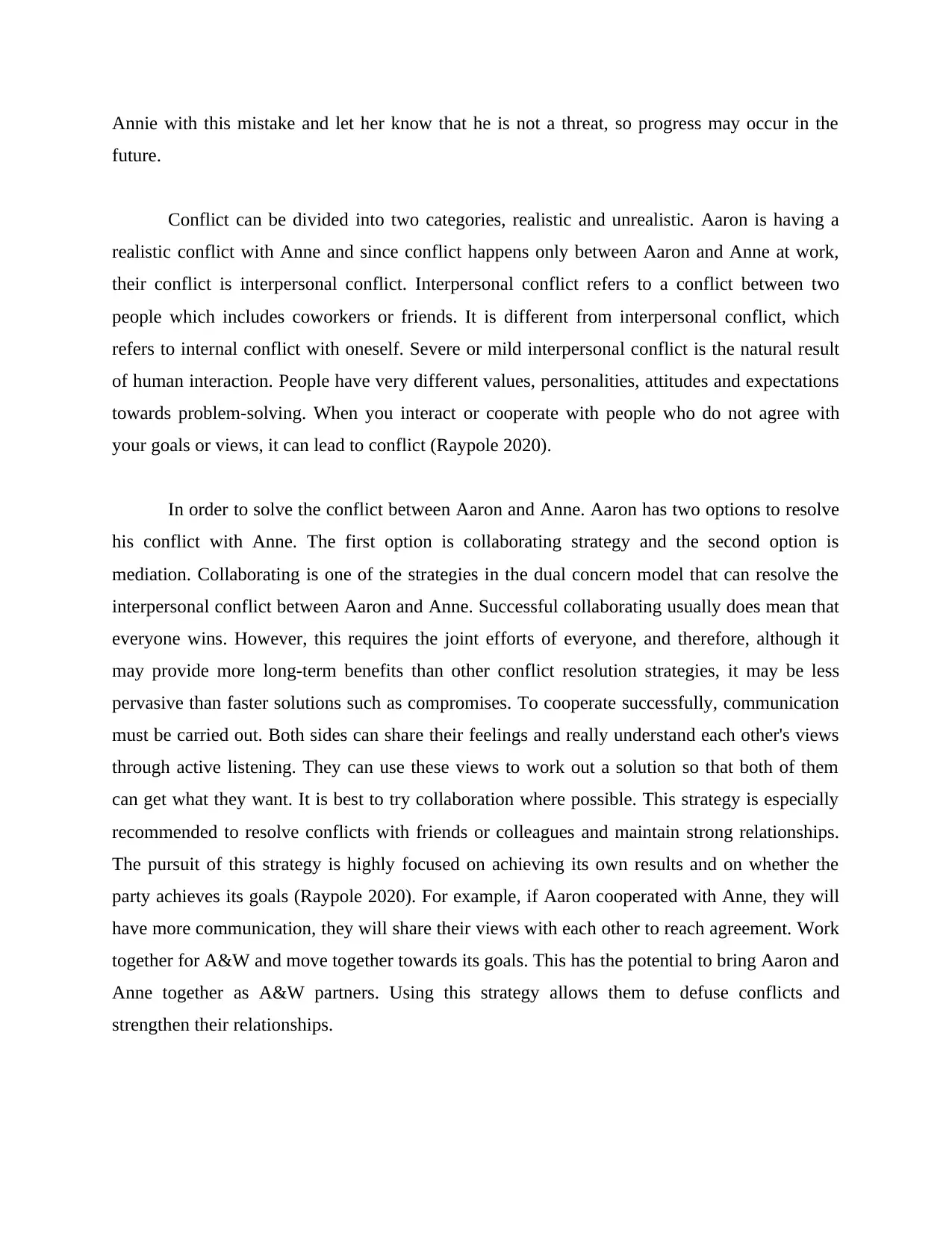
Annie with this mistake and let her know that he is not a threat, so progress may occur in the
future.
Conflict can be divided into two categories, realistic and unrealistic. Aaron is having a
realistic conflict with Anne and since conflict happens only between Aaron and Anne at work,
their conflict is interpersonal conflict. Interpersonal conflict refers to a conflict between two
people which includes coworkers or friends. It is different from interpersonal conflict, which
refers to internal conflict with oneself. Severe or mild interpersonal conflict is the natural result
of human interaction. People have very different values, personalities, attitudes and expectations
towards problem-solving. When you interact or cooperate with people who do not agree with
your goals or views, it can lead to conflict (Raypole 2020).
In order to solve the conflict between Aaron and Anne. Aaron has two options to resolve
his conflict with Anne. The first option is collaborating strategy and the second option is
mediation. Collaborating is one of the strategies in the dual concern model that can resolve the
interpersonal conflict between Aaron and Anne. Successful collaborating usually does mean that
everyone wins. However, this requires the joint efforts of everyone, and therefore, although it
may provide more long-term benefits than other conflict resolution strategies, it may be less
pervasive than faster solutions such as compromises. To cooperate successfully, communication
must be carried out. Both sides can share their feelings and really understand each other's views
through active listening. They can use these views to work out a solution so that both of them
can get what they want. It is best to try collaboration where possible. This strategy is especially
recommended to resolve conflicts with friends or colleagues and maintain strong relationships.
The pursuit of this strategy is highly focused on achieving its own results and on whether the
party achieves its goals (Raypole 2020). For example, if Aaron cooperated with Anne, they will
have more communication, they will share their views with each other to reach agreement. Work
together for A&W and move together towards its goals. This has the potential to bring Aaron and
Anne together as A&W partners. Using this strategy allows them to defuse conflicts and
strengthen their relationships.
future.
Conflict can be divided into two categories, realistic and unrealistic. Aaron is having a
realistic conflict with Anne and since conflict happens only between Aaron and Anne at work,
their conflict is interpersonal conflict. Interpersonal conflict refers to a conflict between two
people which includes coworkers or friends. It is different from interpersonal conflict, which
refers to internal conflict with oneself. Severe or mild interpersonal conflict is the natural result
of human interaction. People have very different values, personalities, attitudes and expectations
towards problem-solving. When you interact or cooperate with people who do not agree with
your goals or views, it can lead to conflict (Raypole 2020).
In order to solve the conflict between Aaron and Anne. Aaron has two options to resolve
his conflict with Anne. The first option is collaborating strategy and the second option is
mediation. Collaborating is one of the strategies in the dual concern model that can resolve the
interpersonal conflict between Aaron and Anne. Successful collaborating usually does mean that
everyone wins. However, this requires the joint efforts of everyone, and therefore, although it
may provide more long-term benefits than other conflict resolution strategies, it may be less
pervasive than faster solutions such as compromises. To cooperate successfully, communication
must be carried out. Both sides can share their feelings and really understand each other's views
through active listening. They can use these views to work out a solution so that both of them
can get what they want. It is best to try collaboration where possible. This strategy is especially
recommended to resolve conflicts with friends or colleagues and maintain strong relationships.
The pursuit of this strategy is highly focused on achieving its own results and on whether the
party achieves its goals (Raypole 2020). For example, if Aaron cooperated with Anne, they will
have more communication, they will share their views with each other to reach agreement. Work
together for A&W and move together towards its goals. This has the potential to bring Aaron and
Anne together as A&W partners. Using this strategy allows them to defuse conflicts and
strengthen their relationships.
Paraphrase This Document
Need a fresh take? Get an instant paraphrase of this document with our AI Paraphraser
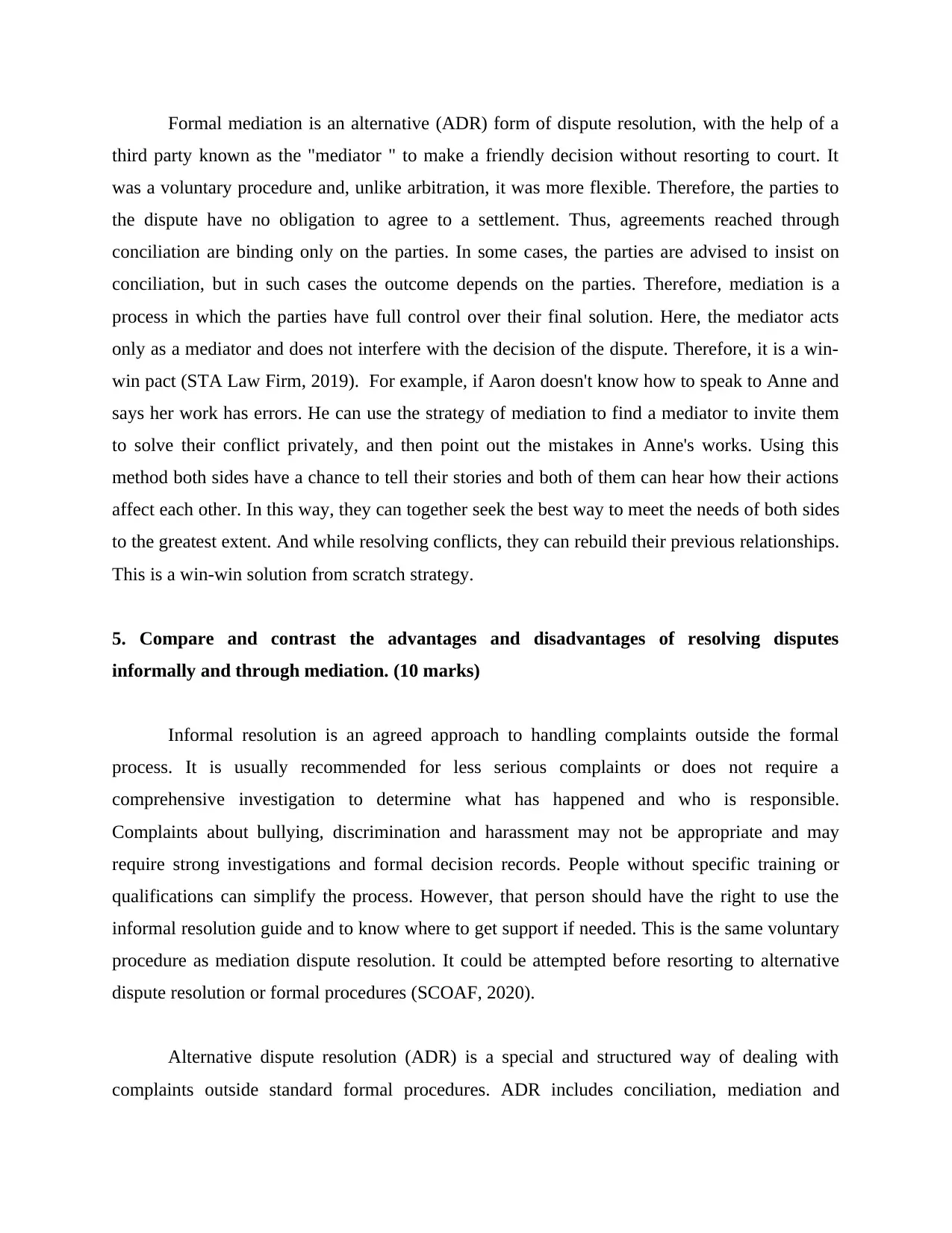
Formal mediation is an alternative (ADR) form of dispute resolution, with the help of a
third party known as the "mediator " to make a friendly decision without resorting to court. It
was a voluntary procedure and, unlike arbitration, it was more flexible. Therefore, the parties to
the dispute have no obligation to agree to a settlement. Thus, agreements reached through
conciliation are binding only on the parties. In some cases, the parties are advised to insist on
conciliation, but in such cases the outcome depends on the parties. Therefore, mediation is a
process in which the parties have full control over their final solution. Here, the mediator acts
only as a mediator and does not interfere with the decision of the dispute. Therefore, it is a win-
win pact (STA Law Firm, 2019). For example, if Aaron doesn't know how to speak to Anne and
says her work has errors. He can use the strategy of mediation to find a mediator to invite them
to solve their conflict privately, and then point out the mistakes in Anne's works. Using this
method both sides have a chance to tell their stories and both of them can hear how their actions
affect each other. In this way, they can together seek the best way to meet the needs of both sides
to the greatest extent. And while resolving conflicts, they can rebuild their previous relationships.
This is a win-win solution from scratch strategy.
5. Compare and contrast the advantages and disadvantages of resolving disputes
informally and through mediation. (10 marks)
Informal resolution is an agreed approach to handling complaints outside the formal
process. It is usually recommended for less serious complaints or does not require a
comprehensive investigation to determine what has happened and who is responsible.
Complaints about bullying, discrimination and harassment may not be appropriate and may
require strong investigations and formal decision records. People without specific training or
qualifications can simplify the process. However, that person should have the right to use the
informal resolution guide and to know where to get support if needed. This is the same voluntary
procedure as mediation dispute resolution. It could be attempted before resorting to alternative
dispute resolution or formal procedures (SCOAF, 2020).
Alternative dispute resolution (ADR) is a special and structured way of dealing with
complaints outside standard formal procedures. ADR includes conciliation, mediation and
third party known as the "mediator " to make a friendly decision without resorting to court. It
was a voluntary procedure and, unlike arbitration, it was more flexible. Therefore, the parties to
the dispute have no obligation to agree to a settlement. Thus, agreements reached through
conciliation are binding only on the parties. In some cases, the parties are advised to insist on
conciliation, but in such cases the outcome depends on the parties. Therefore, mediation is a
process in which the parties have full control over their final solution. Here, the mediator acts
only as a mediator and does not interfere with the decision of the dispute. Therefore, it is a win-
win pact (STA Law Firm, 2019). For example, if Aaron doesn't know how to speak to Anne and
says her work has errors. He can use the strategy of mediation to find a mediator to invite them
to solve their conflict privately, and then point out the mistakes in Anne's works. Using this
method both sides have a chance to tell their stories and both of them can hear how their actions
affect each other. In this way, they can together seek the best way to meet the needs of both sides
to the greatest extent. And while resolving conflicts, they can rebuild their previous relationships.
This is a win-win solution from scratch strategy.
5. Compare and contrast the advantages and disadvantages of resolving disputes
informally and through mediation. (10 marks)
Informal resolution is an agreed approach to handling complaints outside the formal
process. It is usually recommended for less serious complaints or does not require a
comprehensive investigation to determine what has happened and who is responsible.
Complaints about bullying, discrimination and harassment may not be appropriate and may
require strong investigations and formal decision records. People without specific training or
qualifications can simplify the process. However, that person should have the right to use the
informal resolution guide and to know where to get support if needed. This is the same voluntary
procedure as mediation dispute resolution. It could be attempted before resorting to alternative
dispute resolution or formal procedures (SCOAF, 2020).
Alternative dispute resolution (ADR) is a special and structured way of dealing with
complaints outside standard formal procedures. ADR includes conciliation, mediation and
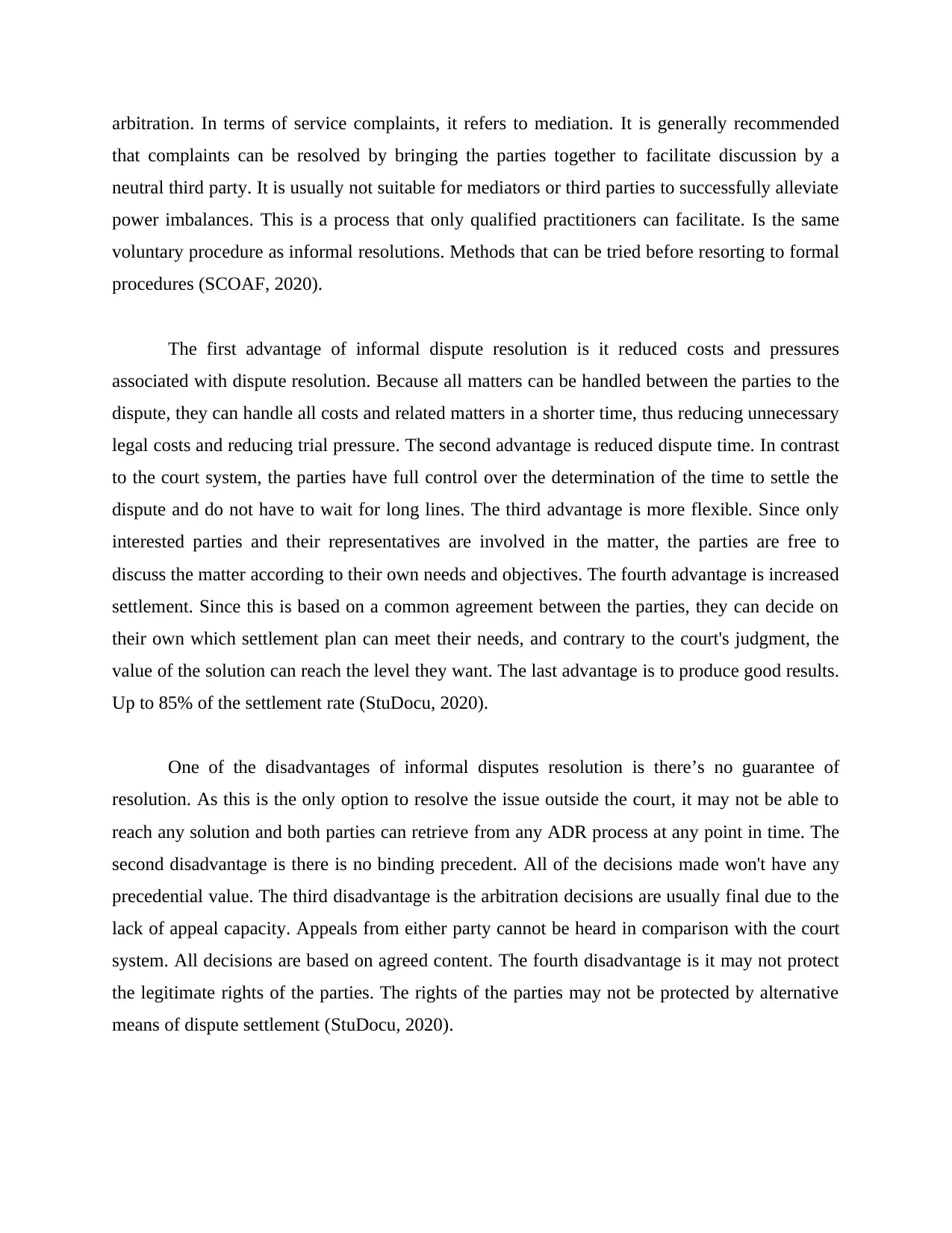
arbitration. In terms of service complaints, it refers to mediation. It is generally recommended
that complaints can be resolved by bringing the parties together to facilitate discussion by a
neutral third party. It is usually not suitable for mediators or third parties to successfully alleviate
power imbalances. This is a process that only qualified practitioners can facilitate. Is the same
voluntary procedure as informal resolutions. Methods that can be tried before resorting to formal
procedures (SCOAF, 2020).
The first advantage of informal dispute resolution is it reduced costs and pressures
associated with dispute resolution. Because all matters can be handled between the parties to the
dispute, they can handle all costs and related matters in a shorter time, thus reducing unnecessary
legal costs and reducing trial pressure. The second advantage is reduced dispute time. In contrast
to the court system, the parties have full control over the determination of the time to settle the
dispute and do not have to wait for long lines. The third advantage is more flexible. Since only
interested parties and their representatives are involved in the matter, the parties are free to
discuss the matter according to their own needs and objectives. The fourth advantage is increased
settlement. Since this is based on a common agreement between the parties, they can decide on
their own which settlement plan can meet their needs, and contrary to the court's judgment, the
value of the solution can reach the level they want. The last advantage is to produce good results.
Up to 85% of the settlement rate (StuDocu, 2020).
One of the disadvantages of informal disputes resolution is there’s no guarantee of
resolution. As this is the only option to resolve the issue outside the court, it may not be able to
reach any solution and both parties can retrieve from any ADR process at any point in time. The
second disadvantage is there is no binding precedent. All of the decisions made won't have any
precedential value. The third disadvantage is the arbitration decisions are usually final due to the
lack of appeal capacity. Appeals from either party cannot be heard in comparison with the court
system. All decisions are based on agreed content. The fourth disadvantage is it may not protect
the legitimate rights of the parties. The rights of the parties may not be protected by alternative
means of dispute settlement (StuDocu, 2020).
that complaints can be resolved by bringing the parties together to facilitate discussion by a
neutral third party. It is usually not suitable for mediators or third parties to successfully alleviate
power imbalances. This is a process that only qualified practitioners can facilitate. Is the same
voluntary procedure as informal resolutions. Methods that can be tried before resorting to formal
procedures (SCOAF, 2020).
The first advantage of informal dispute resolution is it reduced costs and pressures
associated with dispute resolution. Because all matters can be handled between the parties to the
dispute, they can handle all costs and related matters in a shorter time, thus reducing unnecessary
legal costs and reducing trial pressure. The second advantage is reduced dispute time. In contrast
to the court system, the parties have full control over the determination of the time to settle the
dispute and do not have to wait for long lines. The third advantage is more flexible. Since only
interested parties and their representatives are involved in the matter, the parties are free to
discuss the matter according to their own needs and objectives. The fourth advantage is increased
settlement. Since this is based on a common agreement between the parties, they can decide on
their own which settlement plan can meet their needs, and contrary to the court's judgment, the
value of the solution can reach the level they want. The last advantage is to produce good results.
Up to 85% of the settlement rate (StuDocu, 2020).
One of the disadvantages of informal disputes resolution is there’s no guarantee of
resolution. As this is the only option to resolve the issue outside the court, it may not be able to
reach any solution and both parties can retrieve from any ADR process at any point in time. The
second disadvantage is there is no binding precedent. All of the decisions made won't have any
precedential value. The third disadvantage is the arbitration decisions are usually final due to the
lack of appeal capacity. Appeals from either party cannot be heard in comparison with the court
system. All decisions are based on agreed content. The fourth disadvantage is it may not protect
the legitimate rights of the parties. The rights of the parties may not be protected by alternative
means of dispute settlement (StuDocu, 2020).
⊘ This is a preview!⊘
Do you want full access?
Subscribe today to unlock all pages.

Trusted by 1+ million students worldwide
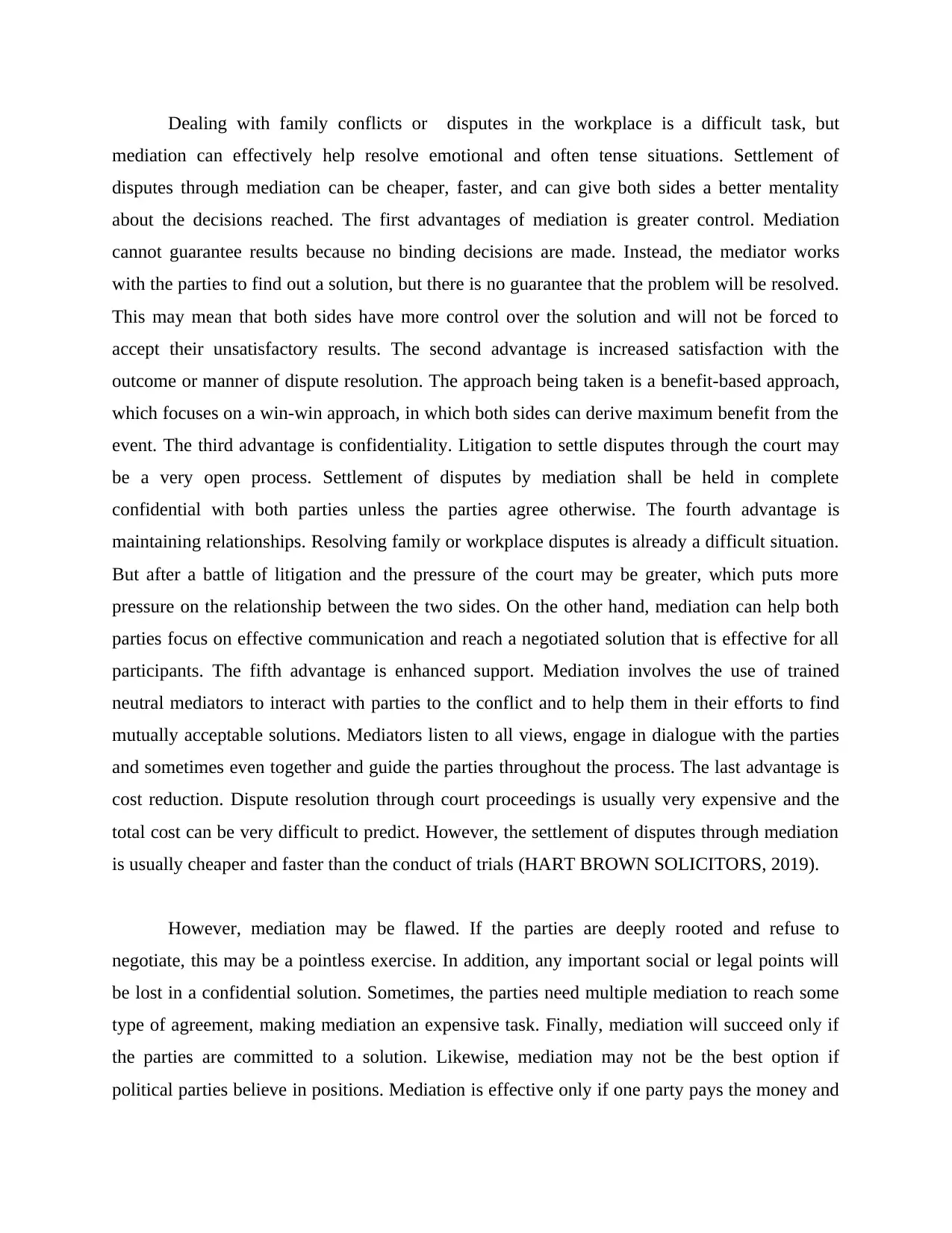
Dealing with family conflicts or disputes in the workplace is a difficult task, but
mediation can effectively help resolve emotional and often tense situations. Settlement of
disputes through mediation can be cheaper, faster, and can give both sides a better mentality
about the decisions reached. The first advantages of mediation is greater control. Mediation
cannot guarantee results because no binding decisions are made. Instead, the mediator works
with the parties to find out a solution, but there is no guarantee that the problem will be resolved.
This may mean that both sides have more control over the solution and will not be forced to
accept their unsatisfactory results. The second advantage is increased satisfaction with the
outcome or manner of dispute resolution. The approach being taken is a benefit-based approach,
which focuses on a win-win approach, in which both sides can derive maximum benefit from the
event. The third advantage is confidentiality. Litigation to settle disputes through the court may
be a very open process. Settlement of disputes by mediation shall be held in complete
confidential with both parties unless the parties agree otherwise. The fourth advantage is
maintaining relationships. Resolving family or workplace disputes is already a difficult situation.
But after a battle of litigation and the pressure of the court may be greater, which puts more
pressure on the relationship between the two sides. On the other hand, mediation can help both
parties focus on effective communication and reach a negotiated solution that is effective for all
participants. The fifth advantage is enhanced support. Mediation involves the use of trained
neutral mediators to interact with parties to the conflict and to help them in their efforts to find
mutually acceptable solutions. Mediators listen to all views, engage in dialogue with the parties
and sometimes even together and guide the parties throughout the process. The last advantage is
cost reduction. Dispute resolution through court proceedings is usually very expensive and the
total cost can be very difficult to predict. However, the settlement of disputes through mediation
is usually cheaper and faster than the conduct of trials (HART BROWN SOLICITORS, 2019).
However, mediation may be flawed. If the parties are deeply rooted and refuse to
negotiate, this may be a pointless exercise. In addition, any important social or legal points will
be lost in a confidential solution. Sometimes, the parties need multiple mediation to reach some
type of agreement, making mediation an expensive task. Finally, mediation will succeed only if
the parties are committed to a solution. Likewise, mediation may not be the best option if
political parties believe in positions. Mediation is effective only if one party pays the money and
mediation can effectively help resolve emotional and often tense situations. Settlement of
disputes through mediation can be cheaper, faster, and can give both sides a better mentality
about the decisions reached. The first advantages of mediation is greater control. Mediation
cannot guarantee results because no binding decisions are made. Instead, the mediator works
with the parties to find out a solution, but there is no guarantee that the problem will be resolved.
This may mean that both sides have more control over the solution and will not be forced to
accept their unsatisfactory results. The second advantage is increased satisfaction with the
outcome or manner of dispute resolution. The approach being taken is a benefit-based approach,
which focuses on a win-win approach, in which both sides can derive maximum benefit from the
event. The third advantage is confidentiality. Litigation to settle disputes through the court may
be a very open process. Settlement of disputes by mediation shall be held in complete
confidential with both parties unless the parties agree otherwise. The fourth advantage is
maintaining relationships. Resolving family or workplace disputes is already a difficult situation.
But after a battle of litigation and the pressure of the court may be greater, which puts more
pressure on the relationship between the two sides. On the other hand, mediation can help both
parties focus on effective communication and reach a negotiated solution that is effective for all
participants. The fifth advantage is enhanced support. Mediation involves the use of trained
neutral mediators to interact with parties to the conflict and to help them in their efforts to find
mutually acceptable solutions. Mediators listen to all views, engage in dialogue with the parties
and sometimes even together and guide the parties throughout the process. The last advantage is
cost reduction. Dispute resolution through court proceedings is usually very expensive and the
total cost can be very difficult to predict. However, the settlement of disputes through mediation
is usually cheaper and faster than the conduct of trials (HART BROWN SOLICITORS, 2019).
However, mediation may be flawed. If the parties are deeply rooted and refuse to
negotiate, this may be a pointless exercise. In addition, any important social or legal points will
be lost in a confidential solution. Sometimes, the parties need multiple mediation to reach some
type of agreement, making mediation an expensive task. Finally, mediation will succeed only if
the parties are committed to a solution. Likewise, mediation may not be the best option if
political parties believe in positions. Mediation is effective only if one party pays the money and
Paraphrase This Document
Need a fresh take? Get an instant paraphrase of this document with our AI Paraphraser
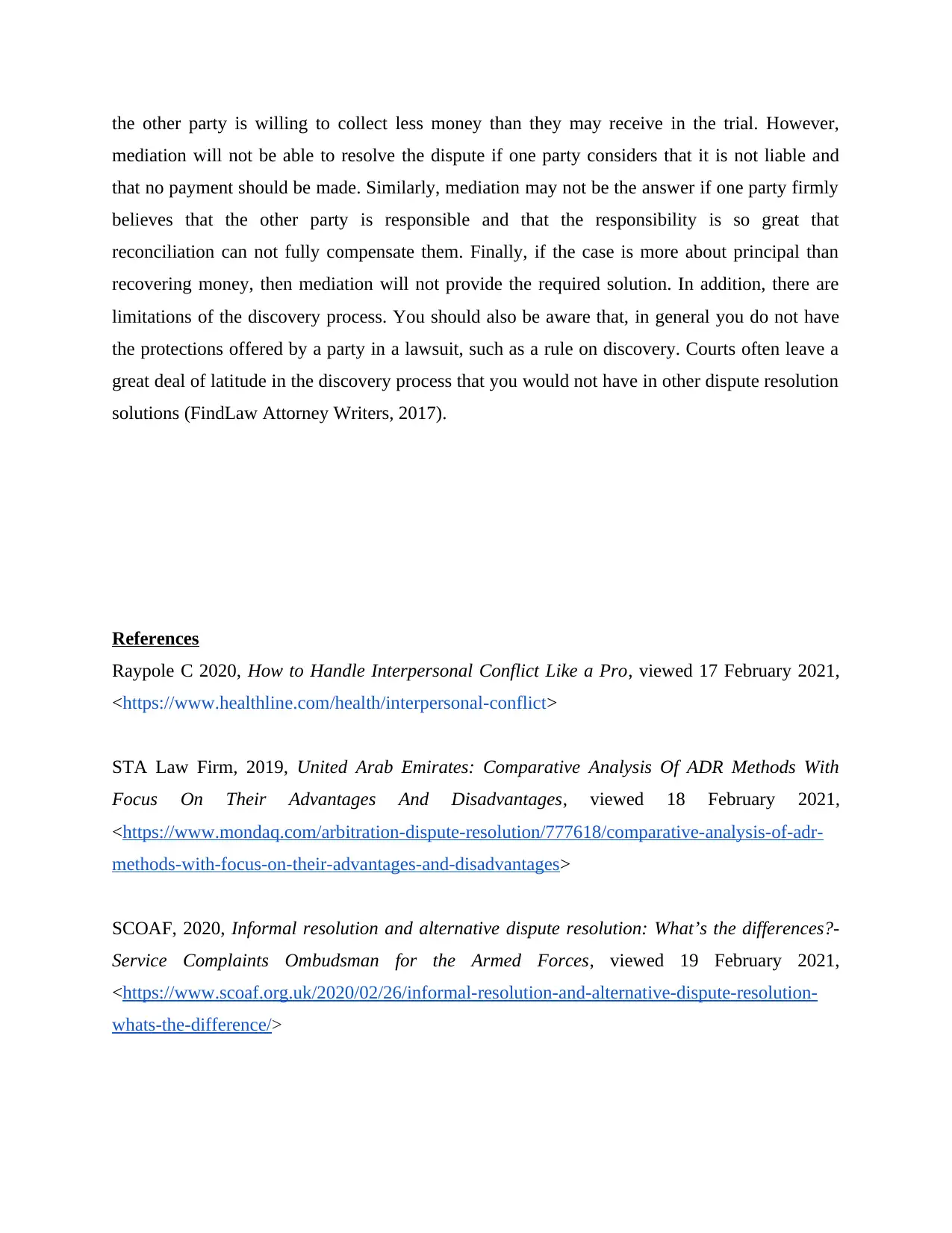
the other party is willing to collect less money than they may receive in the trial. However,
mediation will not be able to resolve the dispute if one party considers that it is not liable and
that no payment should be made. Similarly, mediation may not be the answer if one party firmly
believes that the other party is responsible and that the responsibility is so great that
reconciliation can not fully compensate them. Finally, if the case is more about principal than
recovering money, then mediation will not provide the required solution. In addition, there are
limitations of the discovery process. You should also be aware that, in general you do not have
the protections offered by a party in a lawsuit, such as a rule on discovery. Courts often leave a
great deal of latitude in the discovery process that you would not have in other dispute resolution
solutions (FindLaw Attorney Writers, 2017).
References
Raypole C 2020, How to Handle Interpersonal Conflict Like a Pro, viewed 17 February 2021,
<https://www.healthline.com/health/interpersonal-conflict>
STA Law Firm, 2019, United Arab Emirates: Comparative Analysis Of ADR Methods With
Focus On Their Advantages And Disadvantages, viewed 18 February 2021,
<https://www.mondaq.com/arbitration-dispute-resolution/777618/comparative-analysis-of-adr-
methods-with-focus-on-their-advantages-and-disadvantages>
SCOAF, 2020, Informal resolution and alternative dispute resolution: What’s the differences?-
Service Complaints Ombudsman for the Armed Forces, viewed 19 February 2021,
<https://www.scoaf.org.uk/2020/02/26/informal-resolution-and-alternative-dispute-resolution-
whats-the-difference/>
mediation will not be able to resolve the dispute if one party considers that it is not liable and
that no payment should be made. Similarly, mediation may not be the answer if one party firmly
believes that the other party is responsible and that the responsibility is so great that
reconciliation can not fully compensate them. Finally, if the case is more about principal than
recovering money, then mediation will not provide the required solution. In addition, there are
limitations of the discovery process. You should also be aware that, in general you do not have
the protections offered by a party in a lawsuit, such as a rule on discovery. Courts often leave a
great deal of latitude in the discovery process that you would not have in other dispute resolution
solutions (FindLaw Attorney Writers, 2017).
References
Raypole C 2020, How to Handle Interpersonal Conflict Like a Pro, viewed 17 February 2021,
<https://www.healthline.com/health/interpersonal-conflict>
STA Law Firm, 2019, United Arab Emirates: Comparative Analysis Of ADR Methods With
Focus On Their Advantages And Disadvantages, viewed 18 February 2021,
<https://www.mondaq.com/arbitration-dispute-resolution/777618/comparative-analysis-of-adr-
methods-with-focus-on-their-advantages-and-disadvantages>
SCOAF, 2020, Informal resolution and alternative dispute resolution: What’s the differences?-
Service Complaints Ombudsman for the Armed Forces, viewed 19 February 2021,
<https://www.scoaf.org.uk/2020/02/26/informal-resolution-and-alternative-dispute-resolution-
whats-the-difference/>
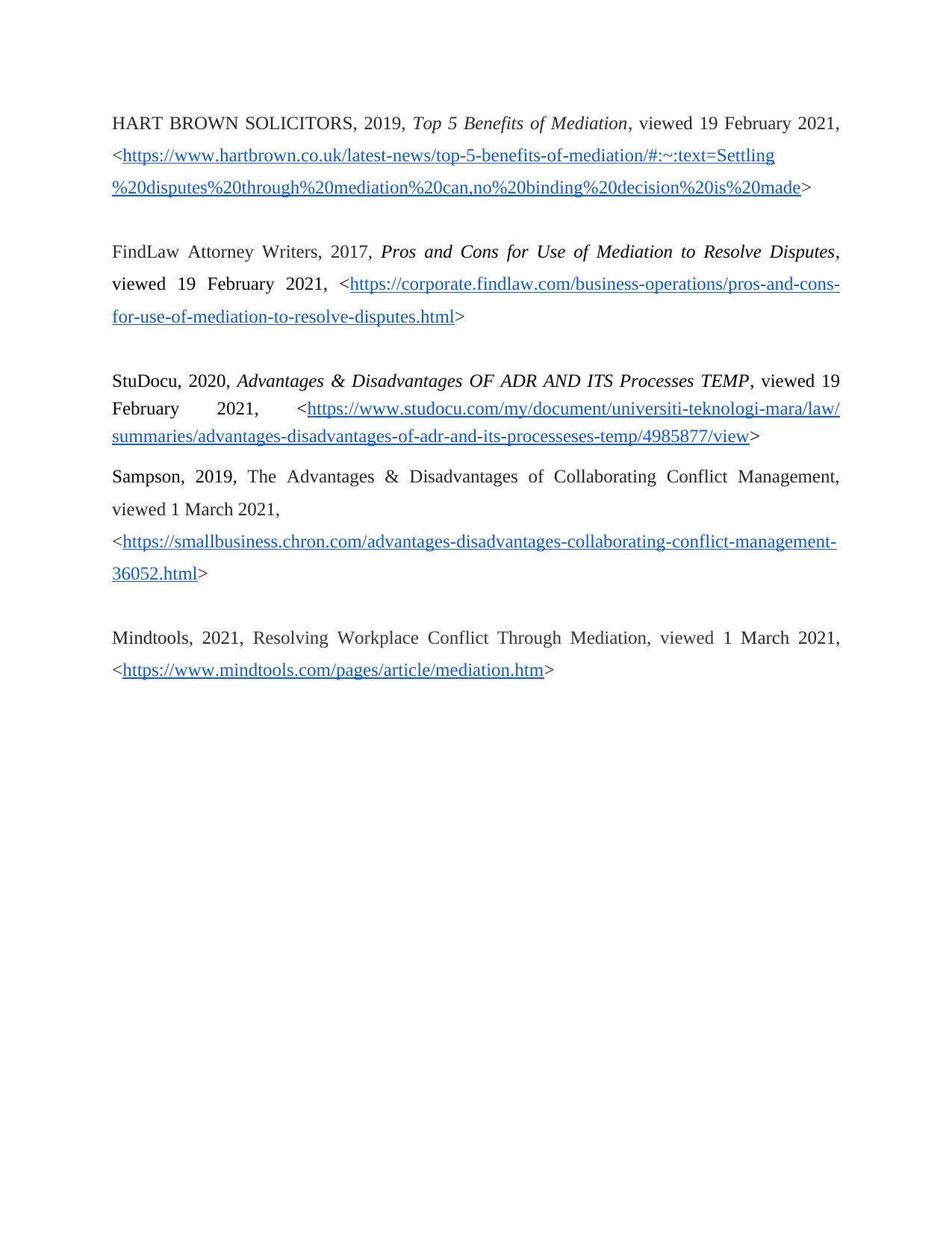
HART BROWN SOLICITORS, 2019, Top 5 Benefits of Mediation, viewed 19 February 2021,
<https://www.hartbrown.co.uk/latest-news/top-5-benefits-of-mediation/#:~:text=Settling
%20disputes%20through%20mediation%20can,no%20binding%20decision%20is%20made>
FindLaw Attorney Writers, 2017, Pros and Cons for Use of Mediation to Resolve Disputes,
viewed 19 February 2021, <https://corporate.findlaw.com/business-operations/pros-and-cons-
for-use-of-mediation-to-resolve-disputes.html>
StuDocu, 2020, Advantages & Disadvantages OF ADR AND ITS Processes TEMP, viewed 19
February 2021, <https://www.studocu.com/my/document/universiti-teknologi-mara/law/
summaries/advantages-disadvantages-of-adr-and-its-processeses-temp/4985877/view>
Sampson, 2019, The Advantages & Disadvantages of Collaborating Conflict Management,
viewed 1 March 2021,
<https://smallbusiness.chron.com/advantages-disadvantages-collaborating-conflict-management-
36052.html>
Mindtools, 2021, Resolving Workplace Conflict Through Mediation, viewed 1 March 2021,
<https://www.mindtools.com/pages/article/mediation.htm>
<https://www.hartbrown.co.uk/latest-news/top-5-benefits-of-mediation/#:~:text=Settling
%20disputes%20through%20mediation%20can,no%20binding%20decision%20is%20made>
FindLaw Attorney Writers, 2017, Pros and Cons for Use of Mediation to Resolve Disputes,
viewed 19 February 2021, <https://corporate.findlaw.com/business-operations/pros-and-cons-
for-use-of-mediation-to-resolve-disputes.html>
StuDocu, 2020, Advantages & Disadvantages OF ADR AND ITS Processes TEMP, viewed 19
February 2021, <https://www.studocu.com/my/document/universiti-teknologi-mara/law/
summaries/advantages-disadvantages-of-adr-and-its-processeses-temp/4985877/view>
Sampson, 2019, The Advantages & Disadvantages of Collaborating Conflict Management,
viewed 1 March 2021,
<https://smallbusiness.chron.com/advantages-disadvantages-collaborating-conflict-management-
36052.html>
Mindtools, 2021, Resolving Workplace Conflict Through Mediation, viewed 1 March 2021,
<https://www.mindtools.com/pages/article/mediation.htm>
⊘ This is a preview!⊘
Do you want full access?
Subscribe today to unlock all pages.

Trusted by 1+ million students worldwide
1 out of 9
Related Documents
Your All-in-One AI-Powered Toolkit for Academic Success.
+13062052269
info@desklib.com
Available 24*7 on WhatsApp / Email
![[object Object]](/_next/static/media/star-bottom.7253800d.svg)
Unlock your academic potential
Copyright © 2020–2025 A2Z Services. All Rights Reserved. Developed and managed by ZUCOL.





